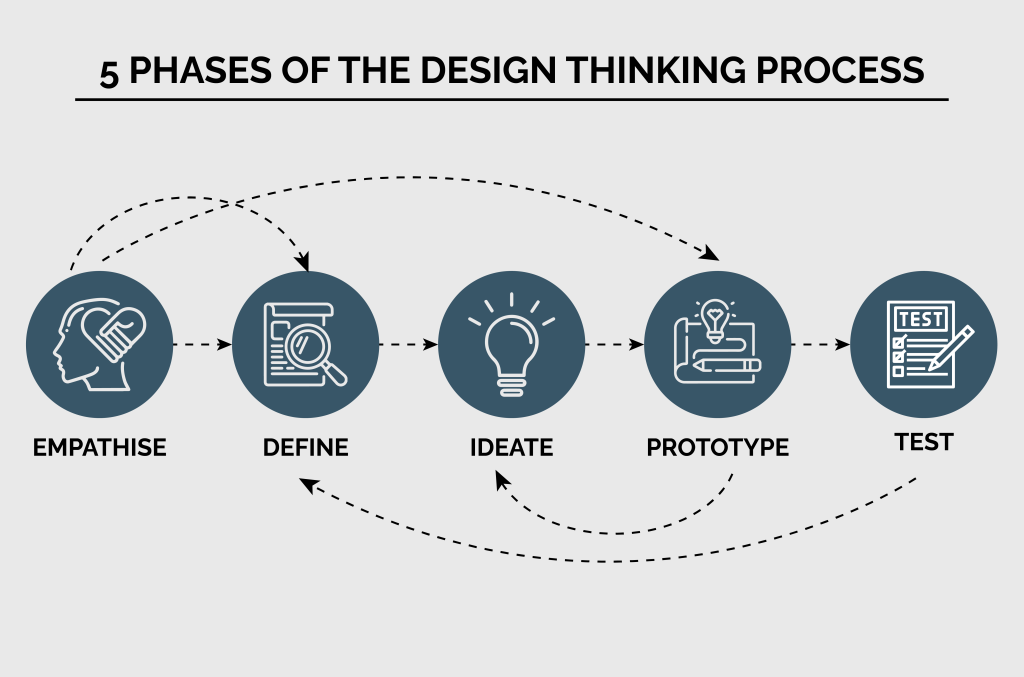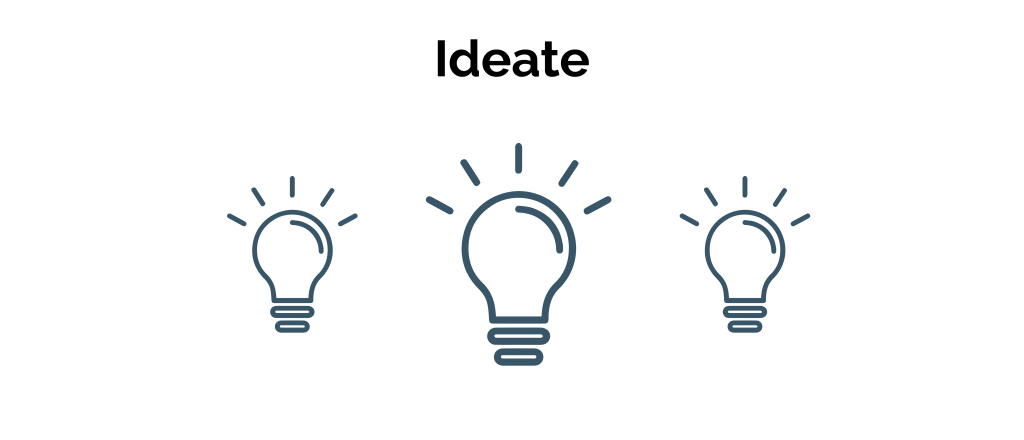UX research is a vital stage of the design process. In the world of digital design, research can be complex, wide-reaching, and very detailed. So, how do you ensure that your UX research is focused and purposeful? And what role does ideation play in the UX process? In this blog, we’ll answer all these questions and more.
What is Ideation?
Ideation is a creative process used by design departments around the world to allow teams to organically generate new and exciting ideas. There is a popular theory that suggests there are five phases to the “Design Thinking Process.”

As you can see, “Ideate” is the third stage of the design thinking process, following “Define” and preceding “Prototype”. While the “Define” stage is about finding links and patterns of insight to create a meaningful point of view, Ideation is about expanding on this point of view and coming up with workable ideas. Participants in this sort of design process are encouraged to be open-minded and produce as many ideas as possible to address the stated problem. There is no room for judgment at this stage.
The Characteristics of Ideation
Usually, there are three main characteristics to every ideation session:
1. Ideas are not evaluated:
Freedom to think and speak is critical to the success of an ideation session. This means that all judgment is postponed until a later point in the design process. Ideation is all about getting the creative engine up and running. Too much evaluation can stifle creativity. Therefore it is important for ideation sessions to run free from evaluation.
2. Collaboration encourages diverse ideas:
The group environment is key. Ideation cannot happen in isolation. In groups, you will be able to come up with a greater number and variety of design ideas. If you have an open group environment then this will allow everyone to share their ideas. This will also help to strengthen team dynamics and instill confidence throughout the group thus improving the chances of success for your designs.
3. Everything is documented and preserved:
It is important that all ideas are recorded and the entire session is documented in a logical format. It should be easy for you to go back and see what ideas you came up with and how you generated those ideas. This can be done with pen and paper or in some digital format. When you document everything you ensure that no useful ideas will be forgotten. Moreover, if you have these ideas written on a whiteboard during the ideation session this can help to inspire further ideas. While these characteristics are important for a productive ideation session, don’t let them restrict you. Allow for a little flexibility and adapt your sessions to suit the strong points of your team and the focus of your project.
Why is Ideation Important?
Ideation helps to fuel innovation. Everyone is searching for that killer idea, that lightbulb moment. Ideation gives you a better chance of generating interesting and unique ideas because it encourages freedom, collaborative and proactive discussions.

The stronger your ideation stage is, the easier your prototyping and testing stages will be. This is because you will have already considered a wide range of problems and solutions before your product and service even interacts with consumers. Without ideation, a problem statement would merely remain a problem and never advance into anything productive.
When a team of designers set their collective energy and innovation to a problem, ideas can be generated at an extremely fast pace.
Some of the key benefits of using ideation in a design process include:
- It helps to incorporate different elements of a variety of ideas together to address real user needs
- It allows the design team to focus on user pain points and find appropriate solutions
- Helps to refine ideas and combine a variety of perspectives
- Allows everyone on the design team to spend time thinking creatively and without judgment. It gives the mind the time, space, and environment needed to think outside the box
Using Ideation in Your Design Process
Ideation is often the most exciting stage in a Design Thinking project. This is because during the ‘Ideation Phase’, the aim is to generate a large number of ideas that the team can then filter and cut down into the best, most practical, or most innovative solutions.
This approach is capable of inspiring new and better design solutions and products. There is the freedom to think and experiment and have fun. If you’re about to begin your design process or if you are already in the middle of creating a product, we’d recommend incorporating as much ideation as possible into your workflow. It’s bound to give you great results!
To learn more about the importance of ideation in UX research please get in touch with our UX experts.
Nothing found.